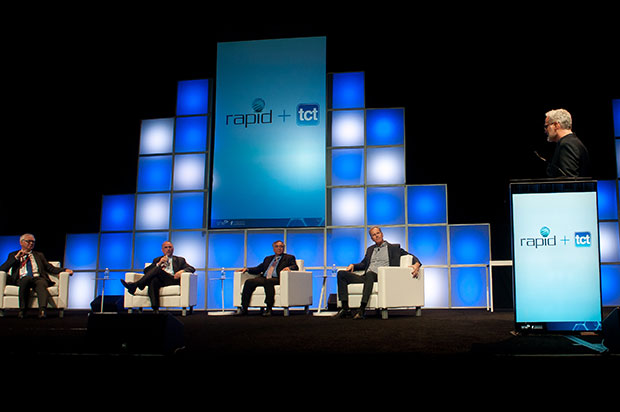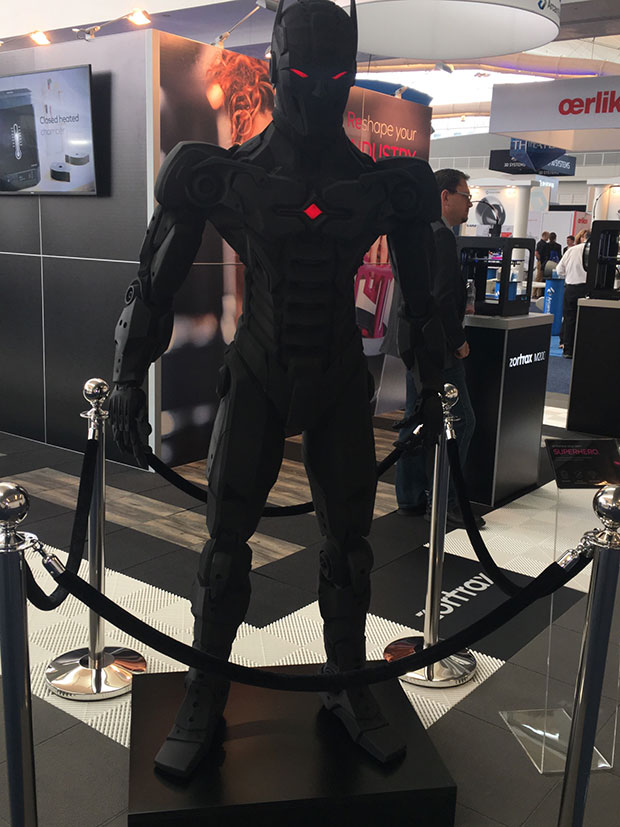RAPID + TCT 2017: 3D Printing Alliances Build Bridges to the Future

A panel discussion moderated by Mickey McManus (Autodesk/MAYA). Left to right: Fried Vancraen (Materialise); Greg Morris (GE Aviation); Vyomesh Joshi (3D Systems); Stephen Nigro (HP).
May 12, 2017
This year’s RAPID + tct conference for additive manufacturing brought thousands of attendees to Pittsburgh, aka the Steel City and City of Bridges. The event for the 3D printing/additive manufacturing community revealed an industry making great strides in the realm of new machinery and materials, including metal; advances in 3D printed medicine; transformation of manufacturing processes and much more.
The idea of building bridges threaded various components of the show together, be it companies announcing partnerships and collaborations or speakers advising that the industry’s strength lies in its ability to work together. The floor housed thousands of square feet of exhibitor space for hundreds of manufacturers of materials, printers, scanners, accessories, post-processing equipment and more. In all, the show bridged familiar manufacturing processes with up-and-coming trends.
Following is a snapshot of the four-day event that ran May 8-11.
Kicking Things Off
“You haven’t seen anything yet,” Mickey McManus, research fellow of Autodesk and chairman at MAYA, boldly told the audience during the opening keynote as he shared his vision of the industry’s future and how to move forward.
 A panel discussion moderated by Mickey McManus (Autodesk/MAYA). Left to right: Fried Vancraen (Materialise); Greg Morris (GE Aviation); Vyomesh Joshi (3D Systems); Stephen Nigro (HP). Image courtesy of Michael Drazdzinski.
A panel discussion moderated by Mickey McManus (Autodesk/MAYA). Left to right: Fried Vancraen (Materialise); Greg Morris (GE Aviation); Vyomesh Joshi (3D Systems); Stephen Nigro (HP). Image courtesy of Michael Drazdzinski.He talked of the infinite loop among making and learning and trends. “The future of making things and learning things is radically changing,” he says, as he delved into the philosophy behind making things, and asked: “If we can make anything and we can make it right, what is the right thing to make?”
He added that it’s not about just one big megatrend of everything being connected in the world of Internet of Things, for example. The IoT is intersecting with some other megatrends as well, including digital manufacturing, machine learning and generative design.
In hypothesizing about what’s to come in the realm of generative design, McManus said, “The generative design idea goes such that we basically set a few set points and a few goals and then the system plays with us, sort of like a jazz improvisation. This is an exploration of what would happen if one person had the power of 10,000 engineers.”
The power of 10,000 engineers could certainly fuel another group with a visible presence at this year’s RAPID. Rob Gorham, the new executive director of the not-for-profit America Makes in Youngstown, kept the show rolling with an announcement of the new America Makes @ program.
The goal for America Makes is to establish more relationships with more organizations to advance the additive manufacturing industry. The program will offer cost sharing credits in lieu of annual membership dues to allow members and nonmembers to receive dollar credit for specific activities the group recognizes such as attending America Makes only events, offering discounted services, for examples.
America Makes also developed a tool to “house information assets.” The not-for-profit partnered with Siemens and Deloitte to create the America Makes digital storefront. It’s a live connection of data to the voice of the industry, according to Gorham, serving as a technology and workforce development roadmap.
Tech Talk
Exploration of latest technology was top of mind for Todd Grimm of T.A. Grimm & Associates, a 25-year veteran of the additive manufacturing and 3D printing industry.
“There’s a floodwater of technology,” he said. “This year you’re going to be drinking from a wall of floodwaters raging toward you. New technologies are coming at us like an avalanche.”
He provided snippets of information pertaining to a “short list” of content potentially relevant to the audience. Topics included advances in binder jetting, directed energy deposition, material extrusion, material jetting, powder bed fusion, sheet lamination, vat photo polymerization, and hybrid manufacturing.
Grimm shared numerous announcements, including:
- An agreement between Essentium and BASF for materials; Essentium is sheathing the filament with nanoparticle matter, carbon nanotubes on the exterior. They’re extruding the material and perform an electrical welding process.
- Formlabs announced the Form Cure and Form Wash – automated tools on the back end of their vat photo polymerization process.
- A new company, Paxis, has a new technology called WAV – wave-applied voxel, inherently scalable and configurable, according to Grimm.
There are metal materials under research, programmable materials, bulk metallic glass and magnetic materials to name a few.
 Embrace your superhero. One of many 3D-printed objects spotted on the show floor of RAPID+TCT’s annual conference in Pittsburgh.
Embrace your superhero. One of many 3D-printed objects spotted on the show floor of RAPID+TCT’s annual conference in Pittsburgh.Panel Discussion
Later, during a “Transformation of Manufacturing” panel at the opening session, moderator McManus of Autodesk and MAYA, directed his thoughts to the panel. “Additive manufacturing today is one piece of the puzzle,” he said. “What will it do as traditional ways of manufacturing shift? Where do the experts see the transformation of manufacturing happening? How do we get past traditional use of these technologies into an expressive use?”
In the transformation of manufacturing, there are three items that jump out as necessary, according to GE Aviation’s Greg Morris: reduction of development time, starting from a system level vs. a part level, and simplification of the supply chain.
HP’s Stephen Nigro built on Morris’ top 3: “If we are going to transform the world—you can’t do it on your own. Leverage the world. We have this philosophy that we’re going to be an open platform.”
He said HP has distilled this transformation down to six must-have items to go after manufacturing: “One, it’s about the machines and products; two, it’s about cost; three, it’s about materials; four, it’s about design for additive; five, there are new supply chains; and six, pay attention to standards and regulations.”
3D in Metal Printing
The second day of the show featured a panel on Frontiers in Metal 3D Printing.
On the panel was Don Jones, director of global aftermarket parts at Caterpillar, who says the company has been involved with additive manufacturing since 1991. A recent new move for them is the aftermarket.
“The transformation we are undergoing is how can we use this technology to stop less parts in distribution centers. Metal has not been profitable to print at this point and difficult because of the environment. There’s not a global supply chain yet,” Jones said. He added that Caterpillar’s wish list includes an ability to print parts much closer to customers reduce lead time and cost, and recognize the sustainability movement (to print parts closer). “This metal 3D printing technology is a game changer in aftermarket.”
For Ric Fulop, CEO of Desktop Metal, “Metal printing requires a new way of thinking. At most universities, there’s no course on design for additive. In five years, or 10, that will be different. It’s important to teach next generation how to do it,” he said during the panel.
As for Kyle Nel of Lowes Innovation Labs, the real issue requires the industry to take a step back even further than college education. “‘I think we grossly underestimate how difficult the education piece is for regular people,” he said. “Here we are at this conference having these deep conversations when the vast majority of people don’t even know what 3D printing really is.”
Some current limitations in the metal realm, according to experts at RAPID, are linked to cost of technologies, materials costs and productivity of machines. “It ends up not making sense in except in high-end cases,” such as aerospace and healthcare, said John Dulchinos of Jabil. “Ultimately building out the supply chain requires ability to build to scale.”
iTeam launch
During the metal 3D printing session, SME launched an additive manufacturing evaluation methodology, SAM-CT, as the Independent Evaluation of Additive Manufacturing (ITEAM) consortium. Teaming with Dr. Michael Grieves of the Florida Institute of Technology (FIT)—who claims to be the coiner of the term digital thread—and major industry users in automotive, aerospace and others, ITEAM will provide a virtual repository of additive manufacturing machine/material capabilities. It will offer a virtual, open platform and evaluation tools for users to determine parts’ suitability to be manufactured additively against available machines and materials. Additionally, the open platform can aid the AM community in creation of specialized AM apps.
3D Printing & Medicine
In a session on new materials for 3D printing in medicine, Sue Jordan, M.D., Ph.D., chief resident, plastic and reconstructive surgery, Northwestern Memorial Hospital, shared how various collaborators are working to bring new materials to the medical world to “solve 3D complex problems daily, especially 3D challenges in plastic/reconstructive surgery.”
“3D printing has enabled the ability to develop more sophisticated scaffolding systems, creating complex and versatile 3D printed functional implants,” said Ramille Shah, Ph.D., assistant professor of materials science and engineering and assistant professor of surgery in the transplant division at Northwestern University.
Her team is in the process of developing a biomaterial ink palette—3D-printable inks with printing compatibility. So far, more than 300 particle-laden inks have been and are being developed by the Shah team lab.
“We are developing versatile material ink platforms that greatly expand the number of 3d printable functional materials using a single 3D printing platform,” Shah explained.
Certification
Also during RAPID, Tooling U-SME, workforce development arm of SME, launched certification to support manufacturers that want to increase AM operations and schools that are prepping students for manufacturing careers.
A nationally normalized, stackable or sequential, credential process in additive manufacturing is available via the Additive Manufacturing Leadership Initiative, a collaborative working group representing SME, America Makes, the National Coalition of Advanced Technology Centers, and the Milwaukee School of Engineering and Technician Education in Additive Manufacturing and Materials.
This assessment serves as a prerequisite for the next phase, the Additive Manufacturing Technician Certification, to be rolled out later this year. These stackable certifications can lead to an additive manufacturing apprenticeship.
Additive Design Experience
Yet another innovation at this year’s show was the hands-on workshop provided to 100 participants by The Lanterman Group. Participants could attend one session with experts in the fields of 3D printing and robotics to design and optimize a series of 3D printed multi-legged robots. The Lanterman Group partnered with the Carnegie Mellon University Robotics Institute and Autodesk on the project, called the Additive Design Experience.
Response to the program was highly positive, according to The Lanterman Group Founder Anthony Hughes, who said they had to turn people away due to limited space available. The group is looking for ways to expand the program further in the future.
In closing, America Makes’ Gorham summed up the state of the industry in 2017: “3D printing is no longer new, but is gaining momentum in the mainstream. What had been around for decades is starting to become a household name.”
Piggybacking on those remarks, industry experts such as Mark Cotteleer of Deloitte, said what organizations of tomorrow really need is the digital thread, “a single seamless strand of data that goes from design to finished part. This thread can collect manage and analyze valuable information.”
Grimm’s end-of-show observations centered on partnerships. “There is a new attitude toward partnership,” he said. “To tackle additive manufacturing from a place of ‘we are going to do it all’—is ludicrous.”
“What we are beginning to see is that all companies have a different place—depending on application. There is a whole range of new capability in rapid prototyping,” added Robin Wilson of Innovate UK.
Subscribe to our FREE magazine, FREE email newsletters or both!
About the Author
DE’s editors contribute news and new product announcements to Digital Engineering.
Press releases may be sent to them via [email protected].







